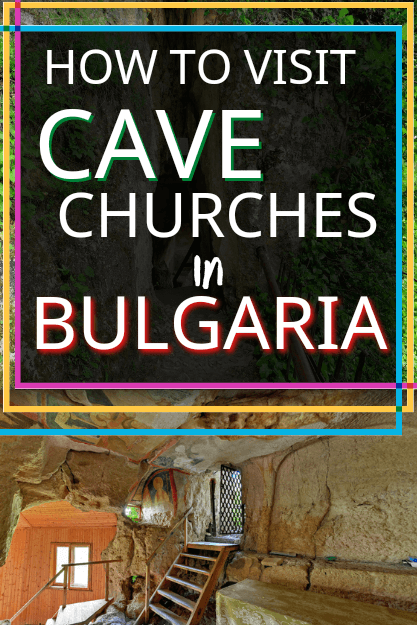Something you may not know about Bulgaria, is that there are a large number of ancient Roman ruins scattered around the country. Plovdiv is no exception.
Thought by many to be the oldest city in Europe, Plovdiv boasts one of the best preserved ancient amphitheatres in the world!

Read on for everything you need to know about the Plovdiv Amphitheatre (also known as the Ancient Theatre of Philippopolis,) and how to visit.
While I say “everything you need to know” I can’t say “all the facts” because as you will soon read, they are as clear as the mud that maybe, or maybe didn’t, bury or un-bury the theatre….yeah.
History of the Plovdiv Ampitheatre
Plovdiv was formerly the ancient city of Philippopolis. The town was founded in 341/342 BC! You don’t see that every day!
Romans took the city in 72 BC and remained in power until the empire fell.

What Year Was the Plovdiv Amphitheatre Built?
The Plovdiv Ampitheatre was constructed around 90 AD, which is just mind boggling when you see it today.
It’s hard to imagine any of Bulgaria’s Brutalist architecture surviving nearly 2000 years, and that stuff is sturdy!
Plovdiv Amphitheatre Construction and Materials
Maybe you aren’t as simple as I am, but I had no idea how ancient Romans built these amazing projects. Turns out, much like they do today.
Ancient Romans had cranes, scaffolding, and even concrete!
The Plovdiv Ampitheatre was made primarily out of marble blocks, which would have been moved into place with a human powered treadwheel crane.

How Did the Plovdiv Amphitheatre Go Missing?
The Ancient Theatre of Philippopolis was mostly destroyed by fire, earthquake, mudslide, or Attila the Hun, in either the 4th or 5th century.
Clear enough?
No? Not for me either.
I LOVE to know the details and history around the places that I visit, but I have spent a lot of time scouring the internet and all I have are theories and no citations.
Even the Wikipedia page has two different versions!
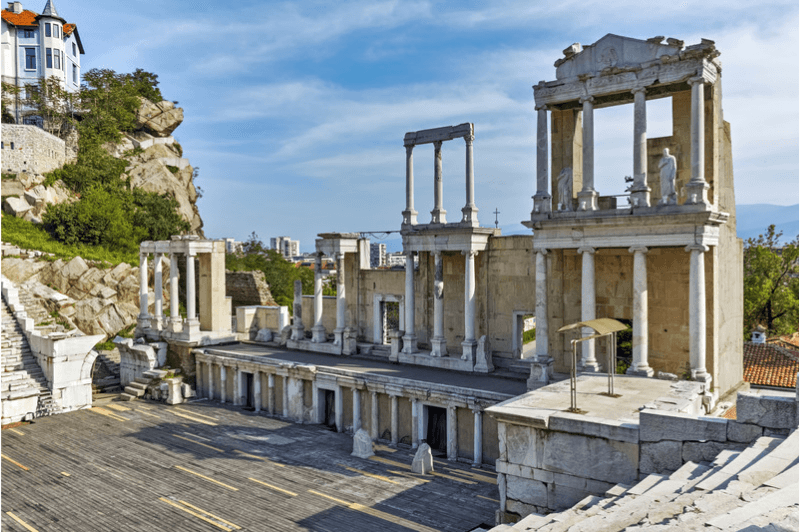
I tend to believe the Attila the Hun story, which is that the amphitheatre was mostly destroyed in an attack around 440 AD. I saw that version of events the most, and that’s at least factual with what was happening around Bulgaria during that time.
When we go back to Plovdiv I will try harder to photograph and translate all the information I can!
That’s the funny thing about Bulgaria, not everything is on the internet yet. If any Bulgarians with trustworthy history books reach this article, please let me know!
Anyway! No matter the reason, the amphitheatre was eventually buried over time, and was “missing” for centuries.
How Was the Plovdiv Amphitheatre Rediscovered?
The ancient theatre was uncovered in 1972 after a “freak landslide”….or perhaps another earthquake. Again, I was not able to find sources for any of these details!
I was hoping to be able to corroborate either the “great Plovdiv landslide of 1972” or the earthquake, but it was not to be.
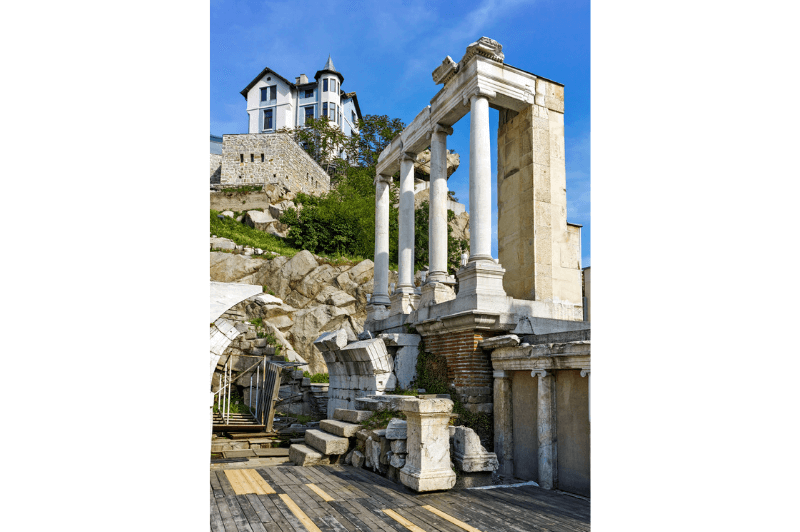
I am quite sure that it wasn’t an earthquake because there are reasonably good records on Bulgarian earthquakes and there wasn’t one in 1972. There was one in 1928 (far too early) and another in 1977, which occurred near Bucharest and caused very little, if any, damage to Plovdiv.
At any rate, there was a small to medium sized natural disaster that either:
- Revealed the amphitheatre
- Revealed a tunnel under the amphitheatre
- Buried enough stuff that a tunnel had to be built
If you’re wondering, yes I’m getting frustrated.
There are a few sources that said the amphitheatre was discovered during work on the tunnel that is underneath it. Combine that with the widespread landslide story and I think what happened, is that a landslide buried part of the town, and rather than dig it out, they decided to tunnel through the slide. That is when I’m alleging that they found the theatre.
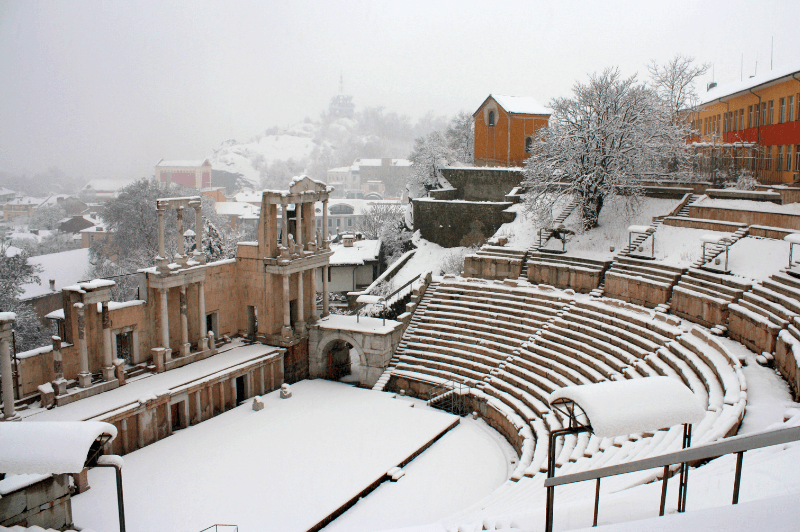
It’s certainly possible that the landslide uncovered the theatre, but since a few people mentioned it being found during the tunnel construction, this version makes the most sense to me.
Again, any Bulgarian history majors, hit me up!
The Plovdiv Amphitheatre Today
Today, while “ruined” the Plovidv amphitheatre is once again in use. It regularly hosts productions and can seat up to 3,000 people.
At it’s original glory the theatre could hold 6,000 – 7,000 spectators, and Roman inscriptions remain in the marble block seats. It’s really an amazing place to be!
Features
The theatre has a stage area with many decorative columns still standing. The backstage is also in operation. Beneath the stands are tunnels leading out to a street, but for daytime visitors the entrance is on the street above the stands.
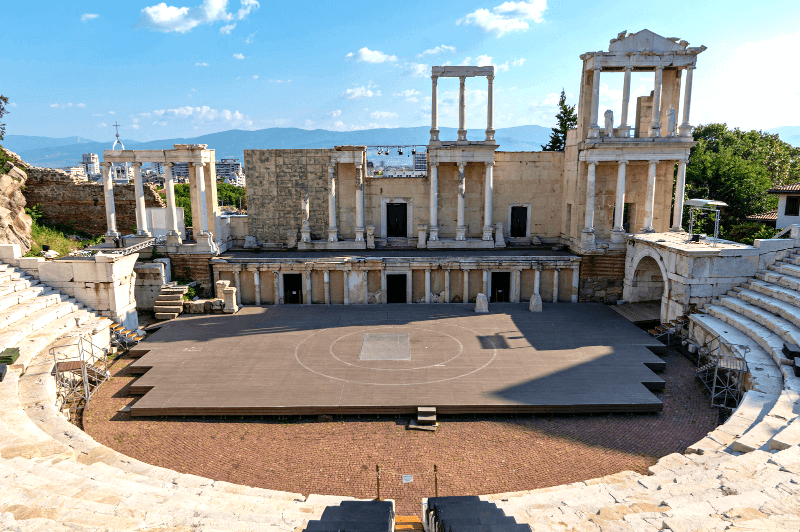
There are stunning views over Plovdiv from the ancient marble seats, and an impressive manor sits on the hilltop to one side. Did I mention it’s an amazing place to be?
Plovdiv Amphitheatre Admission and Hours
The theatre is open daily from 9 am to 6 pm. Tickets are only available in cash at the gate above the stands.
Admission: 5 Lev (3 USD) for Adults 2 Lev (~1.50 USD) for Children
(No age is specified for children, but most places in Bulgaria it is under 10.)
It is well worth it to pay the entrance fee.
It is so affordable and not only can you stay as long as you like, most people don’t bother to go in. When we visited we were alone for most of the time.
Take some time to sit in the stands and take in the views. I don’t know how many ancient sites you can wander around and touch whatever you like, it’s great!

When to Visit the Plovdiv Amphitheatre
I don’t think the theatre ever gets crazy busy, but if you can, go on a weekday. Weekends are obviously the busiest.
From 12 pm to 3 pm is the busiest time across the board. Thursday is the quietest day.
If you plan ahead you could also visit for an event. There are concerts here monthly.
Getting to Plovdiv

Plovdiv does not have an international airport, so you will need to fly to either Sofia, Varna, or Burgas.
Sofia is the closest city and airport, only about a 1.5 hour drive from Plovdiv, all on the highway.
Bulgaria is our favourite place to rent a car, because the rental companies aren’t scammy at all. The highways and main roads are easy to drive on, and no special license is required.
I know as slow travellers we should be advocating for public transport, but the reality is in Bulgaria its just “okay.” We have a child, so we like reliable.
You can bus from Sofia for about $15 USD and it takes about 2 hrs and 20 minutes.
Trains in Bulgaria are notoriously slow and unreliable, so I wouldn’t bother with them.
Getting to the Roman Amphitheatre
The Amphitheatre is walkable from the main pedestrian areas in the old town, and not too far from the ancient town of Plovdiv. Only about 10 minutes on foot.
You could easily have an amazing day in Plovdiv by starting in the old town, walking through the ancient town, and eventually ending up at the theatre.

Straight walking, this route will only take about 20 minutes, but longer if you are exploring along the way.
(Be warned though, it is a bit hilly!)
If you have time on your walk, you can even stop to see the Ancient Stadium of Philippopolis while you’re at it. It is in the old town pedestrian area. Yes, it’s another ancient Roman antiquity right in Plovdiv!

Plovdiv was named the European Capital of Culture in 2019! I wish we had spent more time when we visited and I can’t wait to go back!
Bulgaria is full of amazing treasures, will you be adding Plovdiv to your list?
Want More?

